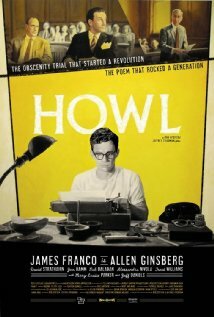In a time where trousers and ties are preferred skinny, and thick-rimmed glasses should be embraced (not mocked, please), and every self-respecting hipster proudly holds a Moleskine and a Penguin Classic in their bag, it seems almost puzzling that there isn’t already a slew of films centering around the so-called “Beat Generation”. Suit-wearing, bespectacled, disillusioned and intellectual, the Beats of 1950s America almost serve as a template to any Gen-Y with hip illusions.
It’s timely then, that Rob Epstein and Jeffrey Friedman’s Howl focuses on Beat icon Allen Ginsberg’s (portrayed superbly by James Franco) poem of the same name. Along with Jack Kerouac’s “On the Road”, I’d venture to say they’re the two most important texts of that particular scene. Certainly, they’re the most popular, and the two that describe the happenings and feelings and personalities of the scene most readily and engagingly. Allen Ginsberg’s seminal poem “Howl” is justifiably considered a classic. Like so many classic texts, however, its reception upon its initial release was fraught with controversy, which is one thing that Howl the film covers.
Like the hippies that followed them in the 1960s, the Beats of the 50s represented a break, a decisive gap and post-war change from the parental generation that came before them. This scene, this world, can only be viewed and experienced by the generations that followed through the photographs and the art that so vividly described it. The world of Jack Kerouac, Allen Ginsberg, Neal Cassasdy, it’s all there in stream-of-consciousness, gorgeous writing (can you tell I’m a fan?) and endlessly, effortlessly cool black and white photos and first-hand accounts.
It was equal parts relief and interest, then, that I discovered in the first few minutes of the film that the directors had chosen to opt for a faux-documentary feel for Howl. Given the impact Ginsberg and his peers have had on generations that came after them, it would have been very easy to place the figures that the poem concerns itself with on hero pedestals. Out when most were firmly in the closet, having written a poem that – for a time – was illegal to sell, it would have been all to easy to paint Ginsberg as a Hero and never anything less glorious (like, for instance, a timid and lovelorn wannabe poet). In my opinion that would have also been a lazy option. Thankfully, the directors play for restraint. Rather than a completely dramatised account of Ginsberg’s life and the process of writing “Howl”, the screenplay has largely been compiled from interviews with Ginsberg himself, as well as transcripts from the poem’s obscenity trial.
Howl cuts between scenes from the obscenity trial, scenes from an interview conducted with Ginsberg (both placed in 1957), and the poem’s first tentative reading at a coffee house in 1955. In addition to this, interspersed throughout the film are adult, often abstract animations based on illustrations by Eric Drooker from his “Illuminated Poems” collaboration with Ginsberg. They accompany a reading of the poem, spread over the film’s running time, eventually covering the “Howl” in its entirety. It seemed fitting of a poet of Ginsberg’s sensibilities that the low-budget film concerning itself with his most popular work would embrace a form so unconventional.
The task of portraying Allen Ginsberg, hero to so many, is not a task to be scoffed at in the slightest. James Franco, while perhaps a little too good-looking even behind glasses, performs admirably. He gets the speech and inflections down pat, having obviously spent countless hours researching his role’s mannerisms. He muses and ponders and smokes during the “interview” scenes, giving a glimpse into the public figure poet Ginsberg was to become. Played with restraint though, Franco also captures the timid uncertainty of the more straightforward biographical flashback scenes of the years preceding “Howl”. Uncertain of his homosexuality, afraid of giving himself emotionally, afraid of his daddy seeing the filth he’d written, we see his crush on Kerouac, his confusing affair with Cassady. Franco is really fine during these scenes in particular, giving the film an emotional grounding. I thankfully found myself forgetting that I had seen him in everything from 127 Hours to General Hospital of late. Also particularly good are the scenes in a crowded, smokey coffee-house, in which Ginsberg reads “Howl” for the first time. In no mean feat, Epstein and Friedman capture the excitement and energy of an audience quickly realising they’re witnessing something great unfolding before them.
The courtroom scenes however, while certainly interesting, suffer from the fact that Ginsberg did not attend the trial of City Lights Books publisher Lawrence Ferlinghetti. Also unfortunate is the fact that we do not see Lawrence Ferlinghetti speak at all. It’s interesting to note though, that the dialogue of the court room scenes are apparently transposed from actual court room transcripts. So one knows that any absurd-sounding exchanges actually took place. As Ferlinghetti’s defense, Mad Men‘s Jon Hamm is strong, if at times seeming to be Don Draper-as-lawyer. Similarly, David Strathairn is good as the prosecution, as is Bob Balaban as a judge. Unfortunately, this portion of Howl never really rises to the heights one would hope it would.
I also took issue with the animations. I acknowledge and appreciate that it was an inventive way to approach the form of the film, as well as a way to include “Howl” in its entirety throughout the film. And certainly, it provides some amazing imagery, complementing the language of the poem. Unfortunately, at times I grew tired of the oft-over-the-top animation. Verdict? A bit much. Frankly, I much preferred the coffee-house reading of the poem. But again, I acknowledge that having the (very long) “Howl” read out entirely in that dimly lit coffee house would have been rather dull, even with Franco’s spirited reading.
In short, Howl is enjoyable and interesting portrait of a cultural icon. Perhaps more interesting for fans of Ginsberg and the Beat generation, but definitely worth tracking down (it’s only in limited release). The animations might be a bit much, but making a film about “Howl” was never going to be an easy, straightforward task. Howl occasionally misses, but mostly it hits, thanks in large part to James Franco, who shines as one of the Beat generation’s most fascinating figures.
 Follow the author Rebecca Mery on Twitter.
Follow the author Rebecca Mery on Twitter.

![Howl [2010] (Review)](/wp-content/uploads/howl_stills_pressefoto_41-e1301532824955-700x350.jpg)

![Howl [2010] (Review) Howl [2010] (Review)](/wp-content/uploads/Howl-franco-as-ginsberg-interviewed.jpeg)













